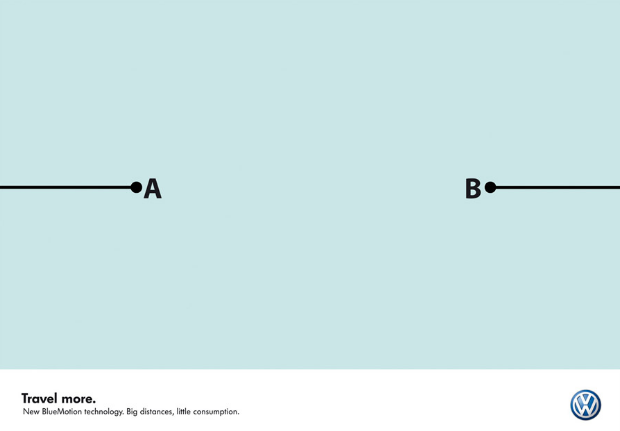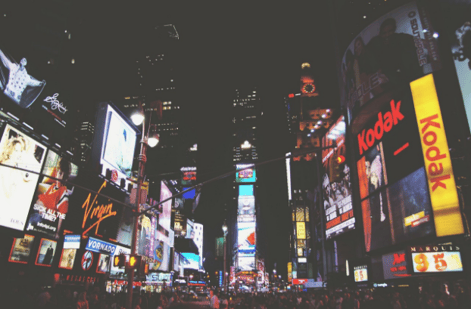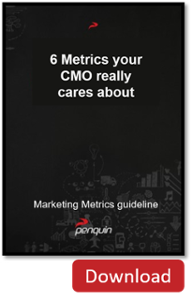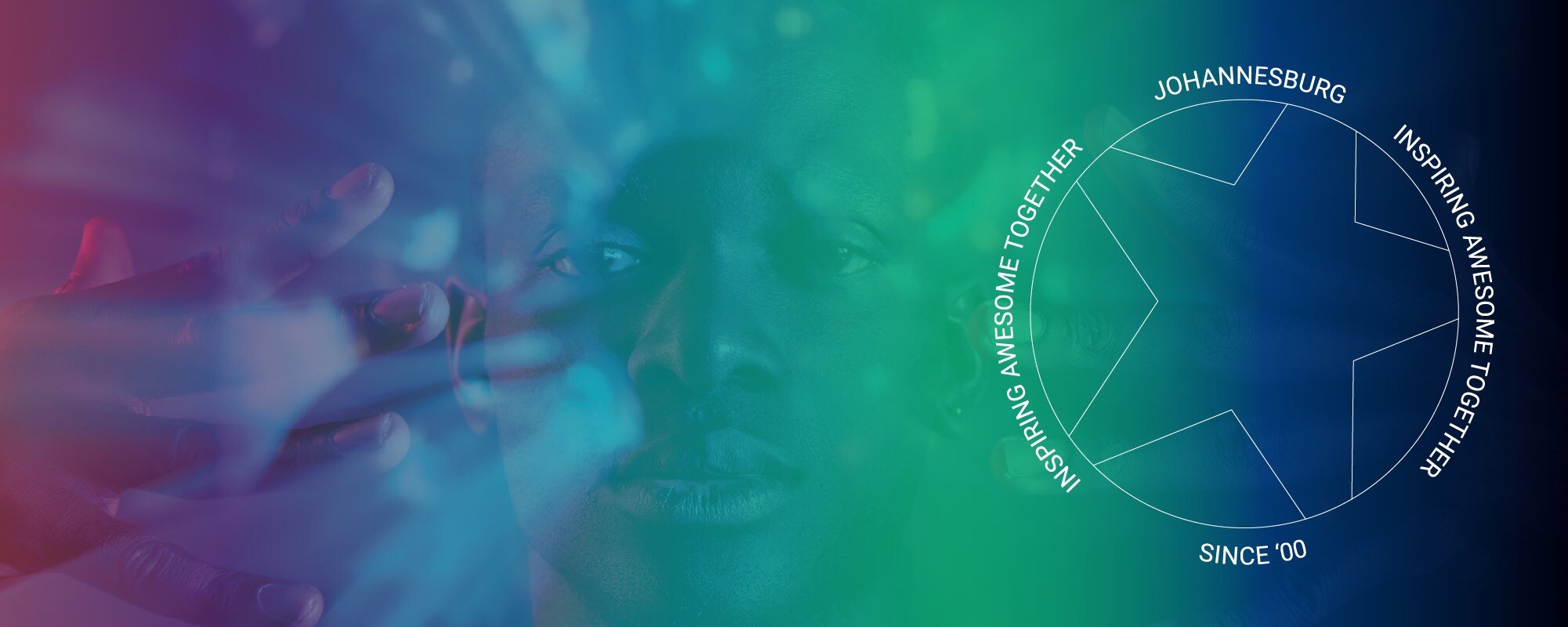
- Less is more
In a world cluttered with advertising, it’s time to focus on doing less, but with more impact. As Forbes writes about memorable adverts (emphasis ours), “Besides hard work, there are usually four key elements in a great ad: a disruptive and relevant visual, strong brand identification, a brilliant headline, and ‘something else’. The something else is a variable.” We recommend focusing on quality - with striking, short, disruptive adverts - rather than long, drawn out, forgettable ads. Andries, Penquin projects director, emphasises this point: “Less will have more of an impact as it is more memorable than trying to remember pages of information.”

This could be because South Africa's slow to adopt to global marketing trends.
Marketers still tend to be over-selling their products and pushing out multiple messages to cover all their bases. The subtle art of being there when you're needed still needs to be applied. In SA, we're still learning that the internet has given consumers the power to find us - we don't need to ensure our brand is in their face 24/7. Hopefully the industry will get there by 2018.
Your brand should aim for more than just exposure: it needs to be out there helping, making connections (human to human) and solving the problems that consumers face.
- Digital campaigns will need to integrate with real-world behaviour
With digital advertising continuing to dominate, there needs to be greater synergy between the digital space, and actual human actions in the real world. “Integrating online behaviour and real-world activations effectively and seamlessly should become the focus of marketing agencies in 2017,” says Andries. An example? Linking car activations with online booking forms for test drives.

The brands that are transacting online give the sense of human interaction and a personal experience. Having said that, there is still a lot of work to be done toward integrating the full customer experience.
From start to finish, the brand ethos has to become more seamless and transparent, so that customers still feel valued - no matter which touch point they choose to engage with.
- Streaming will become ubiquitous
With the growing opportunity to share moments as they happen (with new platforms such as Facebook Live, Snapchat, Instagram Stories and Periscope), live social media is going to become the norm in marketing. Says Andries, “We have become used to seeing pre-produced videos and TVC’s that unless they are phenomenal, we rarely remember the content and rarely do they become viral.” Though brands fear the raw nature of live footage, and the possibility of mistakes, the audience finds the unedited footage and the possibility of a slip up enticing. It’s unpolished nature is very appealing in a world packed with pre-polished and pre-shot adverts and reality television. “Facebook Live video is great for marketers because it gives the ability to create an intimate, authentic connection with your audience. It humanises and personalises your brand,” writes the Social Media Examiner.

Although the intention is to be in the moment, part of the action and authentic - the content still needs to be engaging.
A large portion of the live streaming videos that we see are at events, and although we're trying to share the experience with an audience, there's still a level of detachment, and the content can be boring. Real-life video will continue to rise – but in short bite sized clips that are funny, emotional, relatable and realistic. These will dominate the online space and can easily be captured in the moment, but not necessarily streamed.
- The online retail market share will grow exponentially in 2017
Online shopping continues to grow exponentially in South Africa, and the impact this will have on brick and mortar establishments is definitely going to show in 2017. Says MyBroadband, in an interview with Makro’s e-commerce executive Paul van de Waal, “In Q4 we saw the strongest growth for the year which exceeded our expectations. Traffic grew by over 80% against Q4 2014, and turnover almost doubled.”
We think that online retailers will start expanding their services and there will be a wider variety available for online purchase, with a quicker delivery time.

There's been exponential growth during 2017. The variety of what can be purchased online has exploded, and we're still just scratching the surface.
Whatever your business, be it B2C or B2B, your online offerings will require huge consideration in 2018. It doesn’t matter if it’s free content offers or actual products to purchase, the rise of online shopping will continue grow. Consumers are gaining more trust and becoming more comfortable in this space, so marketers should definitely be considering how to get a piece of the online retail pie.
- Traditional sales practices will change
Your consumers will be better informed in 2017, and do more research before making a purchasing decision. This means that traditional salespeople should focus on building a relationship with their potential customers rather than going straight for the jugular with the hard sale. As Google Trends explains, “Today’s shoppers have become accustomed to doing their own research to get the maximum value out of every dollar they spend, and to feel secure about the purchases they’re making. With this power shift comes a great opportunity for retailers; those that use tools and insights from the web have the opportunity to close the gap between the smart online consumer and the offline retailer, and to stand out in a competitive marketplace.” Consumers know what they want; you need to ensure they get it from you.

In 2018, businesses will be investing more time into aligning their teams and understanding their customers. This will help us understand our customers' motives behind purchases and what steps to take in order to close the deal efficiently.
Relationships are key to any sale. Our market needs to better understand how to build relationships in the digital environment where consumers are shopping. Sales people will need to use more insightful selling, and less forced selling. The marriage between marketing and sales is much like the idea of ‘less is more’.
Marketing will need to identify the customer problems and Sales will need to solve those problems. Building trust and rapport is the only way business is going to continue to succeed. Cold calls and door-to-door sales people won't work in 2018.
- The media buying industry will become tough
Cross-pollination across multiple marketing platforms will occur in 2017. Says Veronica Wainstein, Penquin MD, “Agencies will need to open doors and make more connections within the media industry if they want to retain their media buying power. It will become harder to cherry pick media and this will create more loyalty between media buyers and sellers.”

There's been some good crossover between print and digital, but true collaboration means that media owners need to approach packaging their value propositions more creatively.
Marketers continue to need to stretch their marketing budgets - so media packages that include TV, radio, print and online will be attractive purchases. This does mean, however, that the media industry will need to bury the hatchet, and start collaborating with one another to structure these full value, integrated offerings.
Instead of competing for limited budgets, there needs to be a meeting of the minds. The same way that brands need to focus on putting the consumer first, media owners need to focus on putting the advertisers first.
- There will be a push back against content saturation
With an ever-growing number of companies engaging in content and inbound marketing tactics, the sheer number of content being produced online is overwhelming. Consumers will become more selective in what they consume, and marketing agencies will need to respond to this creatively if they wish to stand out from the crowd.

Again, this goes back to the first point around less is more. Advertisers and brands seem to be stuck in a content producing frenzy.
Way back when, millions of Rands were invested into producing one epic brand TV commercial. The adverts were high quality, exceptionally creative, hard hitting and memorable. With new technology and the constant race against the clock, we've sacrificed quality substantially.
Today’s content is less considered simply because we can put it online and, if it doesn’t work, we can remove it.
The problem is that we've stopped removing it, so the internet is saturated with a bucket load of trash. Useful, helpful, engaging content is few and far between and the average person simply glances over content without actually engaging with it or taking the time to absorb it. As marketers we default to our instincts of yesteryear – just get it out, get it up, paste it everywhere, remarket it, make it bold, rinse and repeat.
2018 is will be bring more consideration on content creation. Consideration of the buying cycle, the customer journey and the relevance of content based on where in the sales funnel the consumer is. Fewer pieces of content with focused messages will outperform the saturation of irrelevant content being pushed out by brands that don’t have the consumers interest at the core of their business.
- LinkedIn will become part of the marketing arsenal
Since being acquired by Microsoft, the realm of possibilities for how LinkedIn can and will be used by companies and individuals alike has grown substantially. From recruitment to marketing, the social media network will entrench itself in marketing campaigns both as a tool, and as a broadcasting platform.
- Too many choices will cause customer indecision
With more available choices than ever, customers will become overwhelmed in making decisions. This will result in more customers sticking to “major players” - and comfort with brands they know as well as tried-and-trusted marketing. Says Revenue Wire, “Engaged consumers buy 90% more frequently, spend 60% more per transaction and are five times more likely to stick with a brand. This means engaged customers deliver three times the value over the course of a year which makes creating and nurturing loyal customers essential for ecommerce businesses.” Grant, Penquin CEO, expands on this, “Advertising focusing on brand loyalty rather than focusing on products will be key for brands in the future.”

The default is always "better the devil you know…" But in 2018 the lesser known brands will work harder for their share of the pie.
The beauty of the digital landscape is that it’s given smaller brands the opportunity to really tell their stories. The big brands currently win by default because they spend millions on building brand awareness. This is a luxury the smaller brands don’t have, but they do have the opportunity to change perception and break conventions with creative storytelling. Brands now have the ability to make a personal connection with individuals. They can bust myths, build trust, be accessible, understand the consumers' needs and guide them to making their buying decision with confidence.
2018 will be the year of the underdog.
How do you see marketing changing in the future?
Follow us on social media for more insights and trends in the marketing and advertising world.
Sign up to our blog to receive monthly insights straight to your inbox to help with your marketing efforts.
Here are some great offers you might be interested in:
 |
 |
 |





SUBMIT YOUR COMMENT